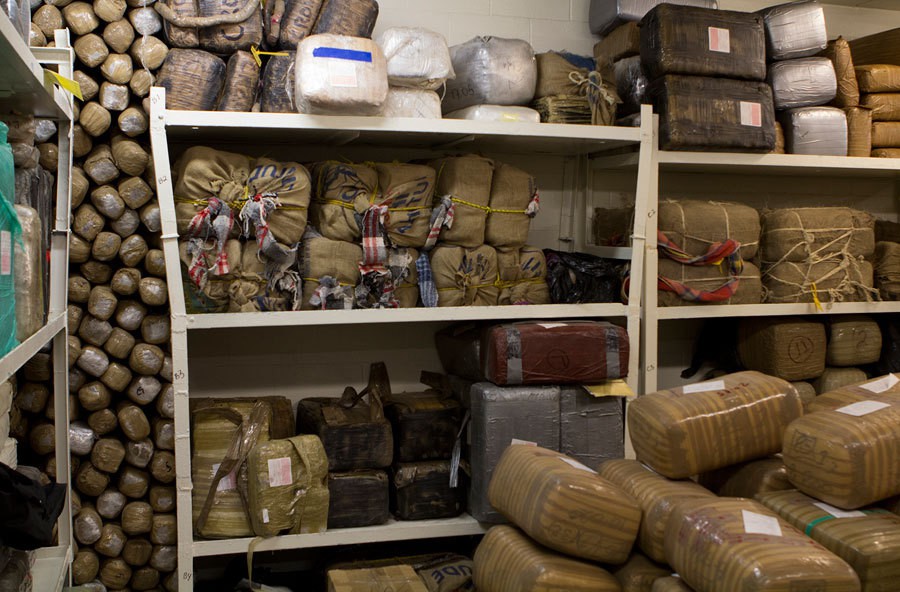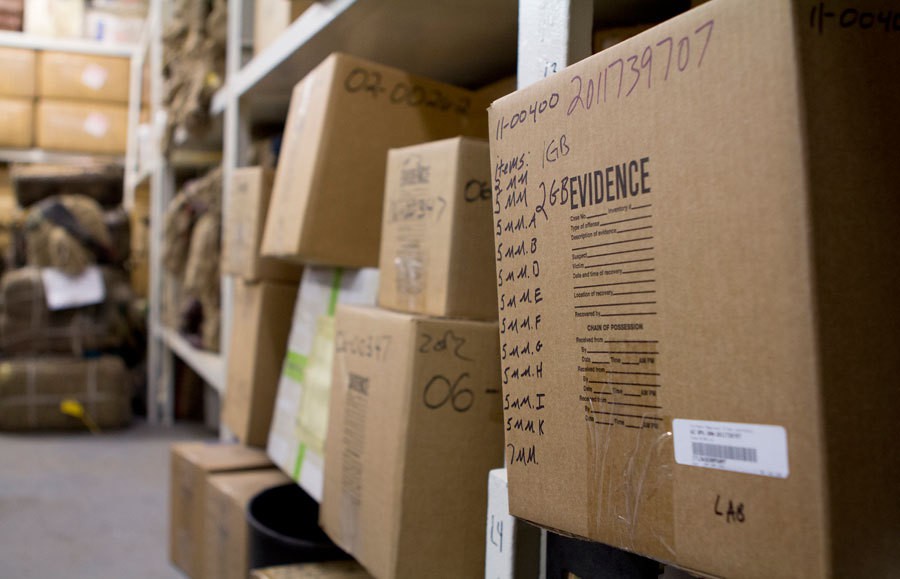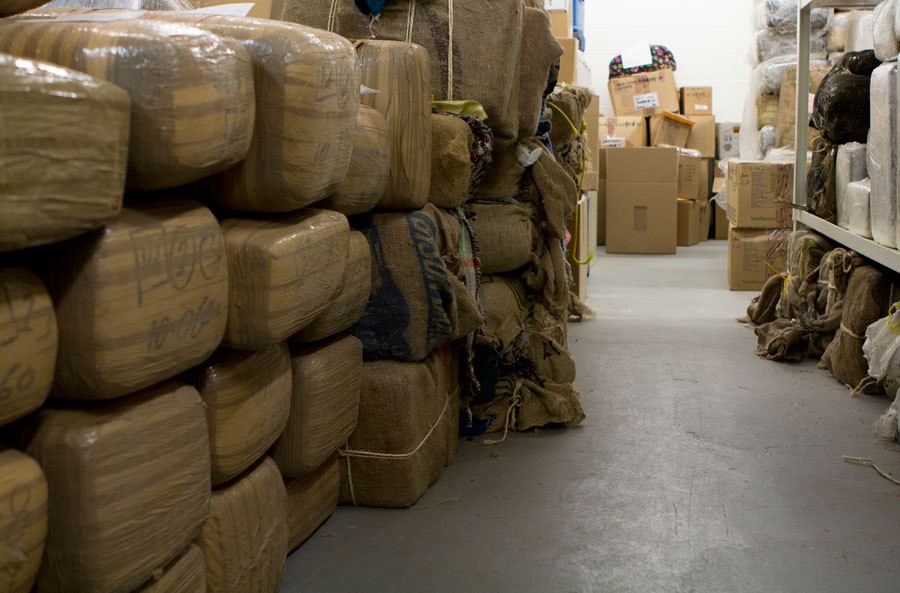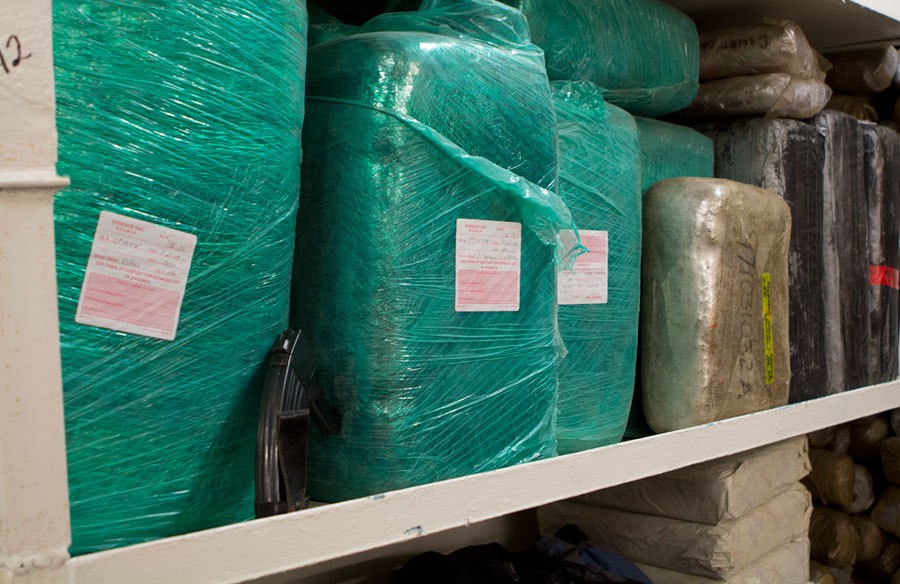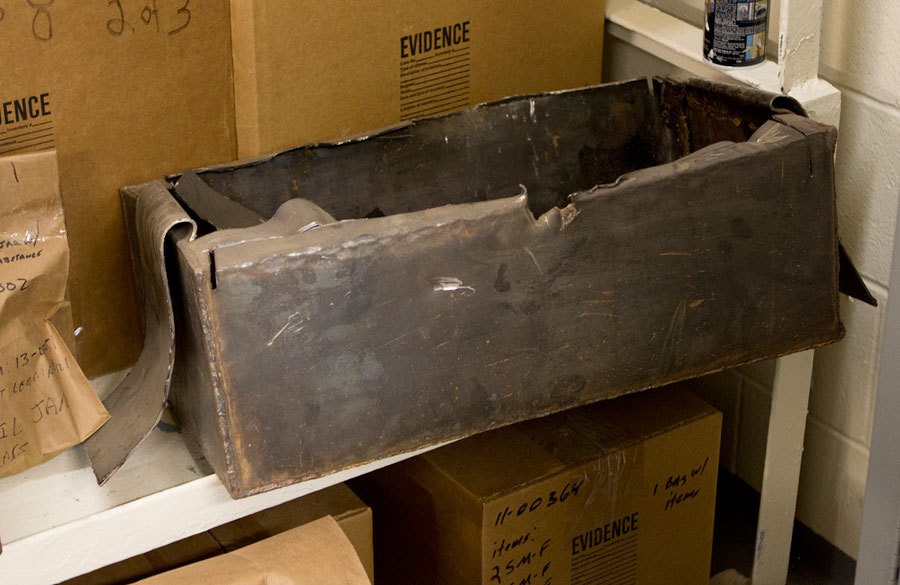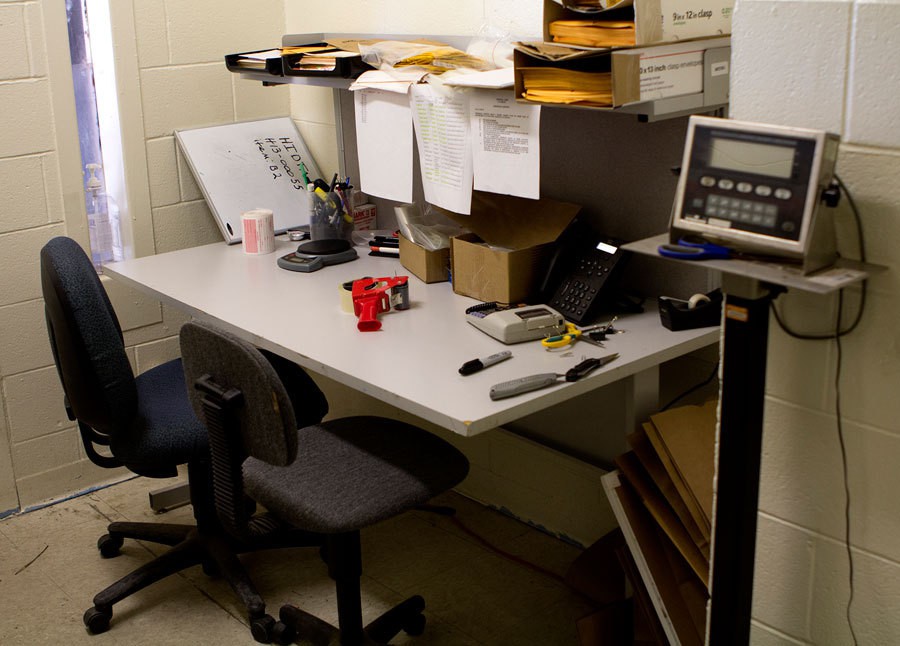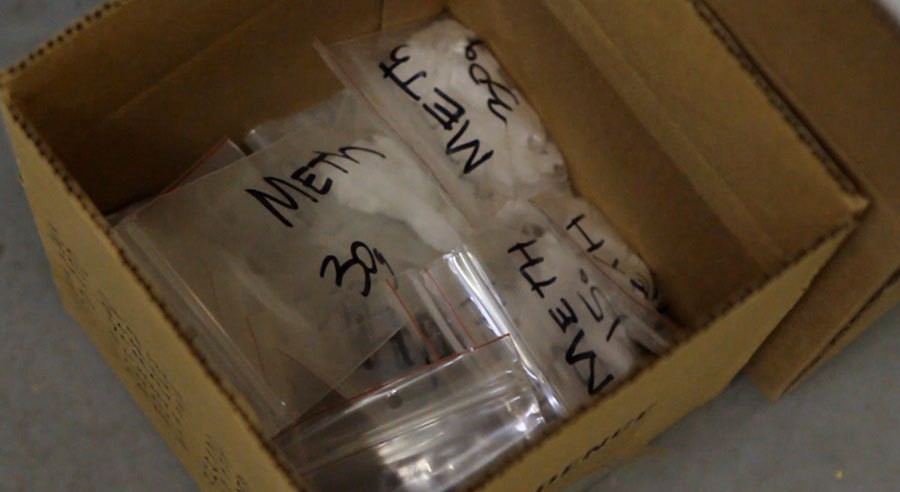Law Enforcement Officials: Flow of Drugs Across U.S. Borders Continues 'Every Day, All Day Long'

By DAVID ROBLES
Cronkite Borderlands Initiative
NOGALES, Ariz.– Cpl. Sergio Lopez sometimes gets the feeling that the mission entrusted to him is an impossible one.
He pauses before he says it and the corners of his mouth curl into a frown under his dark moustache. The 14-year veteran of the Santa Cruz County, Ariz., Sheriff's Department knows the drugs will just keep coming, no matter how hard he works.

A Santa Cruz County, Ariz. Sheriff's deputy patrols the U.S.-Mexico border. Santa Cruz County shares 53 miles of border with Sonora, Mexico. Photo by Lillian Reid. |
In 2012, U.S. Customs and Border Protection seized 1.1 million pounds of narcotics in Arizona. According to a CBP Fact Sheet, Arizona seizures account for half of all drugs seized in the United States. The same goes for apprehensions of people attempting to illegally immigrate.
Gravel crunches under his car's tires as Lopez pulls off the main road and onto a winding dirt path. Lopez is making his regular rounds near the Arizona border city of Nogales, a major port of entry for everything from produce to tourists to kilos of marijuana. On a typical shift Lopez is one of three to six sheriff's deputies patrolling the 53-mile border Santa Cruz County shares with the Mexican state of Sonora. But the deputies are not alone; they rub elbows with dozens of law enforcement colleagues from various agencies: Nogales city police officers, Immigration and Customs Enforcement officers and the nearly 1,000 U.S. Border Patrol agents that serve in Santa Cruz County.
It is not enough to stanch the flow of drugs and immigrants.
"This is every day. All day long," Lopez says from behind the steel grate of the cruiser's cabin, flanked by a Mossberg shotgun and an AR-15 semi-automatic rifle. "You'd be surprised, even in the middle of the day. Right now, they're moving stuff. There could be a group moving right now and I wouldn't know, depending on where they're at."
About 2,500 miles northeast of Nogales, James R. Burns, Jr. sits behind his desk at the U.S. Drug Enforcement Administration's district office outside of Albany, N.Y. His office is decorated with an assortment of exotic narcotics paraphernalia from around the world. An ornate silver opium pipe from Thailand, plastic heroin packaging painted with roaring tigers and Chinese symbols and a curve-bladed Gurkha Kukri knife sit alongside framed photos of Burns with family and colleagues.
Burns is assistant special agent in charge for DEA operations in upstate New York, far from the southwest border and media scrutiny.
"I think on the northern border we have done a pretty good job of securing it. Is it 100 percent secure? Absolutely not, and I don't think that you ever are going to get 100 percent," Burns says.
Burns' work at the DEA is complicated by the geography of the New York border region: bridges at official ports of entry like Buffalo, vast waterways like Lake Ontario and the Akwesasne Mohawk Indian reservation which straddles the U.S.-Canadian border.
"The border is very wide open and I can only talk about the border with Canada in the confines of New York State because that's what I'm responsible for, that's where my experience lies," Burns says. "And it is a very wide open border so if you don't know who's crossing where or when, then I would have to agree, it's not as secure as we might like it to be. But then again, that's the balance that you have to maintain with a democracy. How secure do you want it? How restrictive do you want the movement back and forth across the border to be?"
Burns says that in the winter the rivers freeze over so thick you can drive a truck across and that there are places you walk from the United States into Canada without even realizing it.
"Would I like to see more control over the northern border? Yes. Do I want to shut it down, do I want to make it look like the border in San Diego? Absolutely not."
Two massive international borders, two different approaches to the tremendous tasks of law enforcement, both plagued by the trafficking of illicit drugs fueled by U.S. demand. According to the 2011 National Survey on Drug Use and Health, 22.5 million Americans ages 12 and older were current users of illicit drugs. That insatiable appetite fuels the international criminal organizations that move drugs, people and other contraband across the borders.
The drug threats north and south
On the nearly 4,000 mile northern U.S. border there are numerous U.S. Customs and Border Protection efforts: the Office of Field Operations operates 92 land ports of entry; the Office of Border Patrol covers eight geographic sectors; and the Office of Air and Marine operates from 16 locations coast-to-coast. According to the Office of National Drug Control Policy's 2012 National Northern Border Counternarcotics Strategy, CBP has more than 2,200 Border Patrol agents deployed to the northern border as well as nearly 3,800 CBP Officers policing the flow of people and goods across the ports of entry. Still, that force is dwarfed by the 18,000 Border Patrol agents along 2,000 mile border with Mexico.
Marijuana and ecstasy are the biggest drug threats flowing in from the north, according to the National Northern Border Counternarcotics Strategy. The document says the groups responsible for the cultivation, production and distribution of these drugs in Canada and across the border are generally ethnically aligned. These include Vietnamese-Canadian, Indo-Canadian, Irish-Canadian and Italian-Canadian organized crime groups as well as the Hells Angels Motorcycle Club and independent transnational criminal organizations. Although concentrated mainly in the western Canadian province of British Columbia, ecstasy and marijuana are also smuggled across the border in the eastern provinces of Ontario and Quebec, at or between ports of entry.
But the border with Mexico is the primary gateway for illicit drug smuggling to the United States. According to the U.S. Department of Justice's National Drug Intelligence Center, drug seizures along the southwest border in 2010 accounted for 96 percent of all marijuana seizures, 80 percent of all methamphetamine seizures, 64 percent of all cocaine seizures and 58 percent of all heroin seizures.
"Traffickers use every other avenue imaginable – air, sea and the U.S.–Canada border – to smuggle drugs into the United States," the NDIC's 2011 National Drug Threat Assessment report says. "But the volume moved across the U.S.-Mexico border significantly exceeds that moved through all other routes combined."
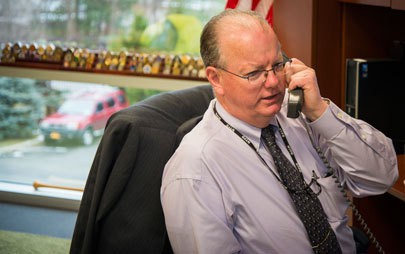
James Burns, is the assistant special agent in charge of the U.S. Drug Enforcement Administration's upstate New York sector. Photo by Lillian Reid. |
80 Percent of DEA seizures in Arizona
Special Agent Ramona Sanchez sits at a conference table in the DEA's Phoenix office. Now going on 10 years as the press information officer here, Sanchez is no stranger to the southwest drug corridor. The DEA veteran worked alongside Special Agent Jim Burns in Los Angeles where Sanchez did everything from undercover work to financial investigations of money laundering to the extradition of major cartel members from Colombia to the United States. She has witnessed the shift of smuggling from the hands of Colombian cartels like those based in Medellin or Cali in the late 1980s to Mexican transnational criminal organizations like the Sinaloa cartel, Los Zetas, La Familia Michoacana and the Gulf cartel, now waging war all along the border for control of key smuggling routes.
The Sinaloa cartel, headed by America's most wanted drug lord, Joaquín "Chapo" Guzmán, currently controls the prime drug corridor in the southwest and is responsible for more than half the illegal drugs trafficked to the U.S., according to the CBP fact sheet. Special Agent Sanchez says more than 80 percent of the drugs DEA seizes in Arizona are from the Sinaloa cartel.
According to the 2011 National Drug Threat Assessment most drugs are trafficked overland but the use of private boats and ultra-light aircraft is on the rise. The cartels smuggle drugs through the ports of entry or over remote, rugged border areas.
"In Mexico you have several 'plazas.' Plazas are … the border towns of Mexico on the other side, the key areas," Sanchez explains. These plazas are Mexican towns at international ports of entry, many of them culturally and socially tied with their American counterpart, only divided by the border fence: Sasabe, Ariz., and El Sásabe, Mexico; Lukeville, Ariz., and Sonoyta, Mexico; Nogales, Ariz. and Nogales, Mexico; Douglas, Ariz. and Agua Prieta, Mexico; Naco, Ariz. and Naco, Mexico; San Luis, Ariz. and San Luis Río Colorado, Mexico.
In all there are 360 miles of shared border with Mexico. In addition to the "plazas," Sanchez explains, there is the Tohono O'odham reservation, which represents about 70 miles of shared border. And, like the Akwesasne Mohawk reservation on the northern border, there are no barriers because it is considered a sovereign nation whose citizens can walk back and forth across the border without any impediment.
Drugs cross the border here in myriad ways. Some go by vehicle through the ports of entry. Some are smuggled in underground tunnels. Some are carried by humans who pack 20 to 50 pounds of marijuana on their backs across the Sonoran desert, make a delivery and walk back. Some are more inventive, like a marijuana bale-hurling catapult discovered in 2011 near Naco, Arizona.
Once on the Arizona side, loads are transported to stash houses in Tucson or Phoenix.
"When you have a distribution cell in Phoenix, obviously the dope from Tucson or Phoenix has to go to U.S. markets across the country," Sanchez says. "A small portion, as a matter of fact, does stay in Phoenix or Tucson, but Arizona is like the feeder state that supplies the U.S. markets like Chicago and Atlanta."
Marijuana is the cartel's cash crop, accounting for more than 50 percent of its profits, Sanchez says. Marijuana is grown cheaply in mass quantities and sold across the United States. As it passes through more hands, the price rises.
"It sells for $450 or $500 a pound (then) it is marked up … (In) Atlanta, it's triple that price," Sanchez says. The more hands the drugs pass through and the farther they travel, the higher the price.
Those mark-ups – the tripling or quadrupling of prices in places like Atlanta, Chicago or Tennessee – are critical to a cartel's operations.
"The profit that they make from the sale of marijuana comes back," Sanchez says. "They use that to finance shipments of cocaine and methamphetamine and heroin -- the more expensive drugs."
More expensive drugs like cocaine are repackaged and distributed not only to large markets in the United States, but they pass through the northern border to Canada. According to the 2011 National Drug Threat Assessment, "Significant quantities of cocaine are smuggled out of the United States into Canada, particularly through POEs in Washington. Canadian authorities assess that the United States is one of the primary transit countries for cocaine destined for their country."
The Royal Canadian Mounted Police corroborated that assessment in their latest Drug Situation Report noting "the majority of cross-border smuggling was by commercial trucks," and that these "northbound shipments were often exchanged for southbound shipments of Canadian-produced marijuana and MDMA."
A local glimpse at a national problem
Peering inside the Santa Cruz County Sheriff's Office evidence storage facility provides a glimpse of the sheer volume of drugs smuggled into the United States. Situated in what used to be the county corrections center on a street with no name in Nogales, Ariz., it houses evidence confiscated by deputies until a case has been closed. It does not include the tons of drugs confiscated by Border Patrol and other federal agents.
The nondescript brown building is surrounded by a green fence topped with barbed wire. The lone evidence custodian, Lorenzo Rodriguez, Jr., is dressed in plain clothes as he walks down a bare hallway to a locked heavy door.
He warns that the evidence locker smells potent enough to make you dizzy, adding that sometimes after working in the room, drug dogs at the Border Patrol checkpoint will signal a positive hit when he drives home.
"You're going to have to look away," he says, chuckling as he enters the security code and turns a large key in the heavy, metal door. The sickly sweet smell of thousands of pounds of marijuana pours out. The room is deep and full of industrial shelves, the floor between them also stacked waist high with evidence boxes.
Rodriguez gestures to his left. "Pretty much this whole side is marijuana. Over there are the narcotics," he says, pointing to the right wall lined with cardboard boxes, "and guns are in the middle." Rodriguez says the facility currently holds between $10 and $15 million dollars worth of illegal drugs, weapons and paraphernalia. The shelves are lined with bales of marijuana wrapped in electrical tape, burlap and canvas. There are cardboard boxes labeled with case numbers containing cocaine, heroin and methamphetamine. A metal compartment once welded to a vehicle now lies in the corner beside long, cardboard boxes containing firearms.
"We are a large consumer of the world's drugs. We are to blame," says Santa Cruz County Sheriff Tony Estrada. "We're providing business for these people and they're very happy to be able to accommodate us."
The soft-spoken sheriff touches his fingertips together pensively from behind his desk and sighs. "The demand continues to be tremendous so the drugs keep flowing. Border Patrol, I think it was last year, got about a million pounds of marijuana. You know, the demand is there and the drugs are coming across.

Santa Cruz County, Ariz. Sheriff Tony Estrada says a completely sealed border is impossible. Photo by Lillian Reid. |
"And like I tell people, they're coming through the ports, they're coming under the ports, they're coming over the ports, they're coming around the ports …They do it by body carriers, in sealed compartments, anything that they can possibly do and I know that the authorities on the ports are discovering new ways on a regular basis of how they're trying to do it, so, it's not going to stop."
As Congress debates what will be considered a secure border, Estrada offers his own view.
"So when you're talking about a secure border, are you talking about zero things coming over? That's never going to happen unless you seal it, unless you completely say nobody's coming over. Then both communities die," he says. "It's impossible, that is never going to happen."
Different problems in the north
Back in Albany, DEA Special Agent Jim Burns breaks down the drug threat in his jurisdiction. Hydroponically grown marijuana from Canada along with MDMA, the main ingredient in ecstasy, flows south into the United States. The money from the sale of those Canadian drugs is used to buy cocaine in the United States that is shipped north into Canada.
According to the most recent National Drug Threat Assessment, "Asian [transnational criminal organizations], principally Canadian-based ethnic Vietnamese criminal organizations, produce MDMA and marijuana in Canada and subsequently smuggle large amounts of the drugs over the northern border for distribution in U.S. markets."
These groups are reportedly moving some operations to the U.S. to escape law enforcement pressure in Canada and lower transportation costs and to avoid risk of seizure at the international border.
An increase in marijuana-growing sites operated by ethnic Asian trafficking groups have been reported in the Pacific, West Central, Great Lakes and New England regions, while the amount of seized MDMA along the northern border increased from more than 1.9 million tablets in 2006 to more than 3.9 million in 2010. The majority of smuggling across the U.S.-Canada border occurs at, and to a lesser extent between, ports of entry in Washington, Michigan, New York, and Vermont.
Burns says the trafficking organizations will approach "just about anybody" for help moving drugs north. Often, he says, the method is simple: a backpack or duffle bag is placed in the cab of a northbound commercial truck.
Burns says the challenge with policing the massive U.S.-Canada border is similar to the problems faced at the Southwest border. But there are far fewer law enforcement agents up north protecting an immense and largely remote area.
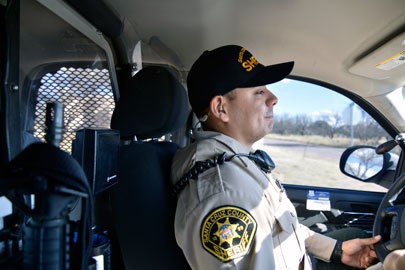
Santa Cruz County Sherriff's Deputy Omar Rodriquez patrols the U.S.-Mexico border outside of Nogales, Ariz. Photo by Lillian Reid. |
"You wouldn't know if you're in Canada or the U.S. with the exception of some international border markers that are spaced very widely along an unmarked, unfenced border," Burns says. "We have border crossings that some of them aren't manned 24 hours a day. They're only manned during the work hours, during the daylight hours."
Waterways like the Great Lakes also pose an enforcement challenge as boats can travel back and forth with ease.
Burns also says the issues facing the Tohono O'odham reservation straddling the border in Arizona are similar to those faced by the Akwesasne Mohawk territory straddling the border in New York.
The reservation "is a key smuggling route for drugs supplied from Canada to New England," according to the NDIC's 2011 New England High Intensity Drug Trafficking Area Drug Market Analysis.
Burns says that in recent years smugglers have approached those living on or near the reservation for jobs smuggling drugs and money across the border. Locals with experience smuggling cigarettes are often approached and hired to smuggle illegal drugs.
Akwesasne Mohawk Grand Chief Mike Mitchell says his tribe is looking for ways to curb tribal members' involvement in smuggling. "[W]e're trying to identify real meaningful jobs, good future, good education. But we're still a target," says Mitchell. He says the tribe is trying to identify and develop legal economic opportunities for its people.
A relatively new challenge in the north, Burns says, is the smuggling of prescription drugs, especially OxyContin, in rural areas like the reservation. He said pharmacies in the United States changed their formula in the last year or so, making it difficult to crush the drug in order to snort it. When the new formula is mixed with water, it gels, preventing it from being injected in a water-based solution. In Canada, the old formulation OxyContin is still being produced.
"So we've seen an influx of OxyContin, the old formulation from Canada into the U.S.," Burns says. With the influx of OxyContin, abuse levels, particularly among the young in rural areas like the reservation have risen. The lack of employment, Burns says, means people are more easily lured into both drug use and drug trafficking.
Erie County Undersheriff MarkWipperman says his office in Buffalo, N.Y., sees all of the problems: cocaine, marijuana, ecstasy and diverted prescription drugs moving across the northern border. But in his county, the problems from both borders intersect: There has been an influx of Mexican drug gangs in the Erie County area.
"They're very sophisticated, they're very, very violent, and they have a lot of resources," Wipperman says. "You can't turn a blind eye to it, and they're trying to take over the territory, which causes drug wars because with turf comes profits. When you hit a search warrant, you not only look for drugs, you look for intel, whether it's computers or sheets and there's evidence that Mexican drug gangs are operating in our areas."
EDITOR'S NOTE: David Robles of the Cronkite Borderlands Initiative reported this story from Nogales, Ariz., Albany, N.Y., and Ontario, Canada.


